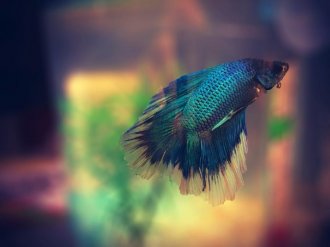
 I have cared for betta fish for years, and at one point owned six betta fish. I have done research on which elements of this fish's environment are crucial to their health. This guide has the basic knowledge you need before buying one of these wonderful fish. Betta fish are also commonly known as Siamese fighting fish. In the wild they live in rice paddies, ponds, or slow-moving streams. They’re a small tropical freshwater fish that’s quite common at most pet stores. They come in a rainbow of colours and there are many variations. Unfortunately, most Bettas are not given the necessary care and they can never show their true colours. Quite literally, because an unhealthy betta has dull, graying scales and their normally beautiful flowing tails are clamped and rotting from stress.
I have cared for betta fish for years, and at one point owned six betta fish. I have done research on which elements of this fish's environment are crucial to their health. This guide has the basic knowledge you need before buying one of these wonderful fish. Betta fish are also commonly known as Siamese fighting fish. In the wild they live in rice paddies, ponds, or slow-moving streams. They’re a small tropical freshwater fish that’s quite common at most pet stores. They come in a rainbow of colours and there are many variations. Unfortunately, most Bettas are not given the necessary care and they can never show their true colours. Quite literally, because an unhealthy betta has dull, graying scales and their normally beautiful flowing tails are clamped and rotting from stress.
Fin rot and clamped fins can be fixed easily with adjustments to the environment and minor medications such as aquarium salt (mentioned later.)
What you must know, is that betta fish do not like each other. Never ever put two fish in the same tank, they will fight to death. Most of the fish in the pet store are male, because female bettas are not only more difficult to care for, but their fins are much shorter and their colours are generally duller. If you are planning on caring for a betta fish with no previous knowledge, I recommend purchasing a male fish.
There are fish compatible with bettas but it’s not recommended for beginner fish keepers. The criteria are that the fish have to be roughly the same size; Isn’t a “fin nipper”;lives in the same water conditions; and that the other fish has dull enough colors that it isn’t mistaken for another betta. Fish types include: Cory Catfish, Loaches, White Cloud Minnows and Red Cherry/Ghost Shrimp. African Dwarf Frogs are also highly compatible with bettas.
Here’s something I learned from experience, don’t listen to the pet store you got Bubbles from. Or, at least take everything they say with a grain of salt. They will try to sell you a tank that’s way too small, or a bowl. Bettas can live in fishbowls, but they thrive when given enough space. A bare minimum would be 2.5 gallons. Most commercial fishbowls marketed for bettas are 0.5 gallons. A wide tank is far better than a deep tank because betta fish need to breathe air. They use an organ called a labyrinth and will die if they can’t easily reach the surface of the water, or if the water isn’t reasonably still. A filter is not necessary, but you will however need to clean the tank at least every other week. You will need a small fish net and some disposable cups or a smaller tank for your fish to reside while you rinse the gravel and rid the sides of algae. Never use household cleaning products to clean your fish tank.
 You will need water conditioner, a bacteria cycler liquid is also extremely useful. The water conditioner should say it’s for betta fish. Make sure you are putting in the right amount for the tank size. Aquarium salt is a medication used for fin rot, and is cheap and good to have around. Use tap water instead of bottled or mineral to fill up the tank. Gravel is useful for keeping the waste created from mixing into the water and looks aesthetically pleasing. Aquarium plants, rocks and ornaments are absolutely crucial to the health of your new fishy friend. Why? Because bettas need somewhere to hide, and something to swim around. Make sure the rocks and ornaments have no sharp edges, betta fins are very delicate and susceptible to tearing. I prefer real plants to silk plants. It’s important to buy healthy plants with no decaying leaves. If there are any fish swimming in the tank with the plants, make sure they all look healthy and none of them have open cuts or sores. Bettas also love plants with big leaves they can rest on, they’re often called the butterflies of the sea. Buy more than one plant, especially with a bigger tank.
You will need water conditioner, a bacteria cycler liquid is also extremely useful. The water conditioner should say it’s for betta fish. Make sure you are putting in the right amount for the tank size. Aquarium salt is a medication used for fin rot, and is cheap and good to have around. Use tap water instead of bottled or mineral to fill up the tank. Gravel is useful for keeping the waste created from mixing into the water and looks aesthetically pleasing. Aquarium plants, rocks and ornaments are absolutely crucial to the health of your new fishy friend. Why? Because bettas need somewhere to hide, and something to swim around. Make sure the rocks and ornaments have no sharp edges, betta fins are very delicate and susceptible to tearing. I prefer real plants to silk plants. It’s important to buy healthy plants with no decaying leaves. If there are any fish swimming in the tank with the plants, make sure they all look healthy and none of them have open cuts or sores. Bettas also love plants with big leaves they can rest on, they’re often called the butterflies of the sea. Buy more than one plant, especially with a bigger tank.
A heater is absolutely essential, especially if you live in a colder climate. Two of my first fish died the night I bought them because they were too cold. If you get a heater, you need a thermometer. There are ones that attach with a suction cup, and stickers. Adjustable heaters are best. If you can, it’s good to fill the tank and test the heater before you buy a fish. Optimal heat is 75F to 82F or 24C to 28C. 26C is perfect.









